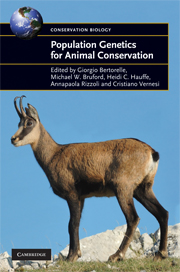Book contents
- Frontmatter
- Epigraph
- Contents
- List of contributors
- Foreword
- Acknowledgements
- 1 Introduction
- Statistical approaches, data analysis and inference
- 2 Statistical methods for identifying hybrids and groups
- 3 How to use MIGRATE or why are Markov chain Monte Carlo programs difficult to use?
- 4 Nested clade phylogeographic analysis for conservation genetics
- 5 A comparison of methods for constructing evolutionary networks from intraspecific DNA sequences
- Molecular approaches and applications
- From genetic data to practical management: issues and case studies
- Future directions in conservation genetics
- Software index
- Species index (common name)
- Species index (Latin name)
- Subject index
5 - A comparison of methods for constructing evolutionary networks from intraspecific DNA sequences
from Statistical approaches, data analysis and inference
Published online by Cambridge University Press: 05 July 2015
- Frontmatter
- Epigraph
- Contents
- List of contributors
- Foreword
- Acknowledgements
- 1 Introduction
- Statistical approaches, data analysis and inference
- 2 Statistical methods for identifying hybrids and groups
- 3 How to use MIGRATE or why are Markov chain Monte Carlo programs difficult to use?
- 4 Nested clade phylogeographic analysis for conservation genetics
- 5 A comparison of methods for constructing evolutionary networks from intraspecific DNA sequences
- Molecular approaches and applications
- From genetic data to practical management: issues and case studies
- Future directions in conservation genetics
- Software index
- Species index (common name)
- Species index (Latin name)
- Subject index
Summary
In phylogeography or population genetic studies, evolutionary relationships among DNA haplotypes can be depicted either as a graph, called a ‘network’, with cycles (or ‘loops’), or as a set of phylogenetic trees (i.e. connected graphs with no circuits), possibly with multifurcation(s) and/or ancestral haplotype(s) (both represented by collapsing zero-length branches). For example, several equally optimal trees inferred under the maximum parsimony (MP) criterion display alternative relationships among haplotypes (Fig. 5.1a, b). A strict consensus tree can be used to summarize this set of trees (Fig. 5.1c), but this approach discards much of the historical information. Indeed, a strict consensus tree is typically compatible with many more alternative trees than those used to build it: e.g. the consensus in Fig. 5.1c is compatible with 105 different strictly bifurcating topologies although only two haplotypic trees have been used to build it. Furthermore, the consensus tree cannot easily summarize branch length information (e.g. in Fig. 5.1, taxon 4 is at the tip of a 0 step-long or a 1 steplong branch in trees (a) and (b), respectively). On the contrary, a network graph allows display much of the information contained in the data in a single figure (Fig. 5.1d). Therefore, the major advantage of such graphs over traditional phylogenetic trees is the possibility of using cycles (loops) to represent either ambiguities in the data or genuine reticulate evolution (due to e.g. recombination or horizontal gene transfer). In parsimony networks, sampled and unsampled haplotypes (white circles and black dots, respectively, in Fig. 5.1d) are symbolized by nodes (vertices) that are connected by edges, where each edge represents a single nucleotide substitution. Unsampled haplotypes are inferred to connect sampled haplotypes when the latter are separated by more than a single substitution. The so-called ‘degree’ of a node corresponds to the number of edges to which it is connected (e.g. in Fig. 5.1d, haplotype 2 is a node of degree 4).
- Type
- Chapter
- Information
- Population Genetics for Animal Conservation , pp. 104 - 120Publisher: Cambridge University PressPrint publication year: 2009

